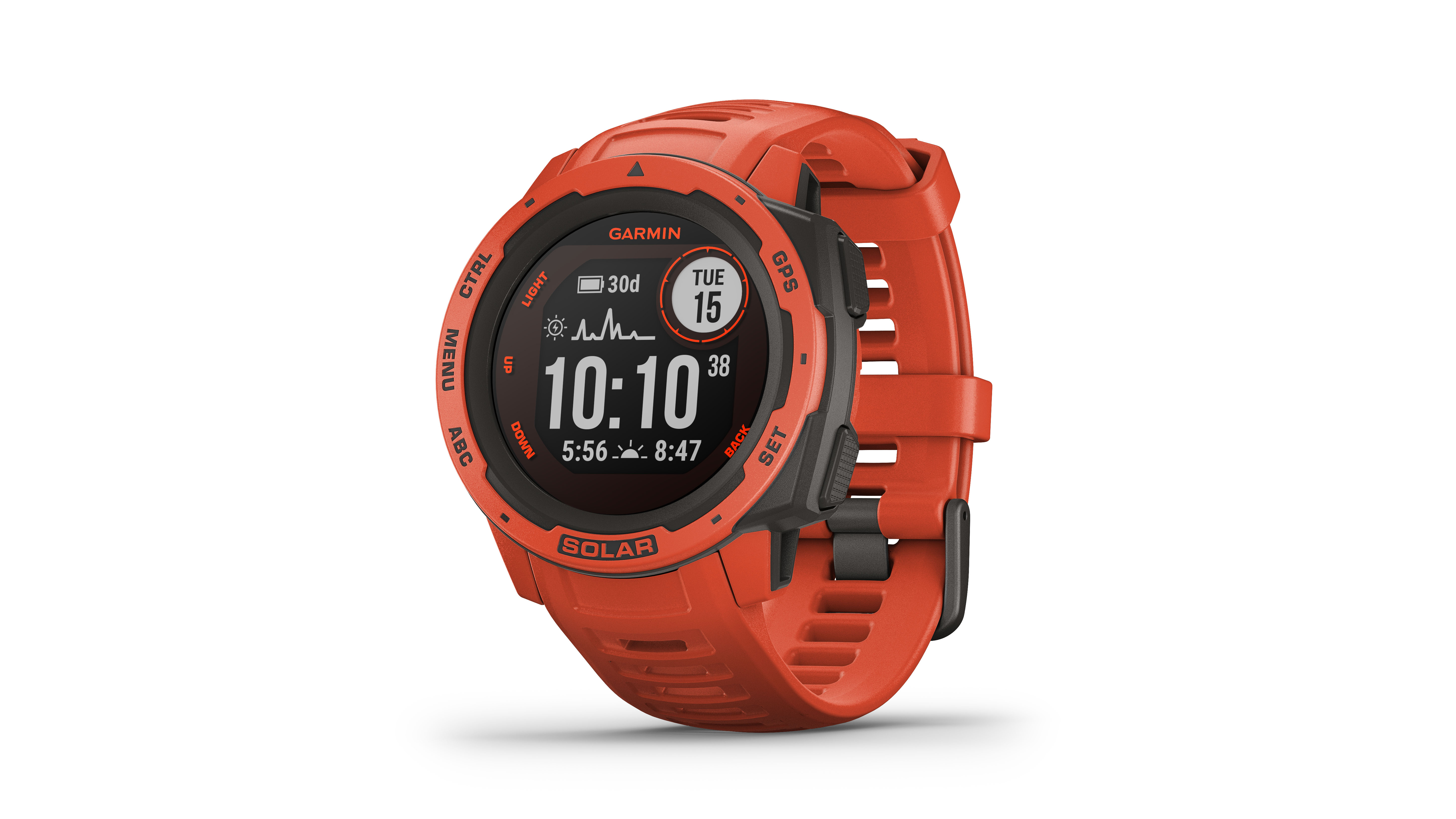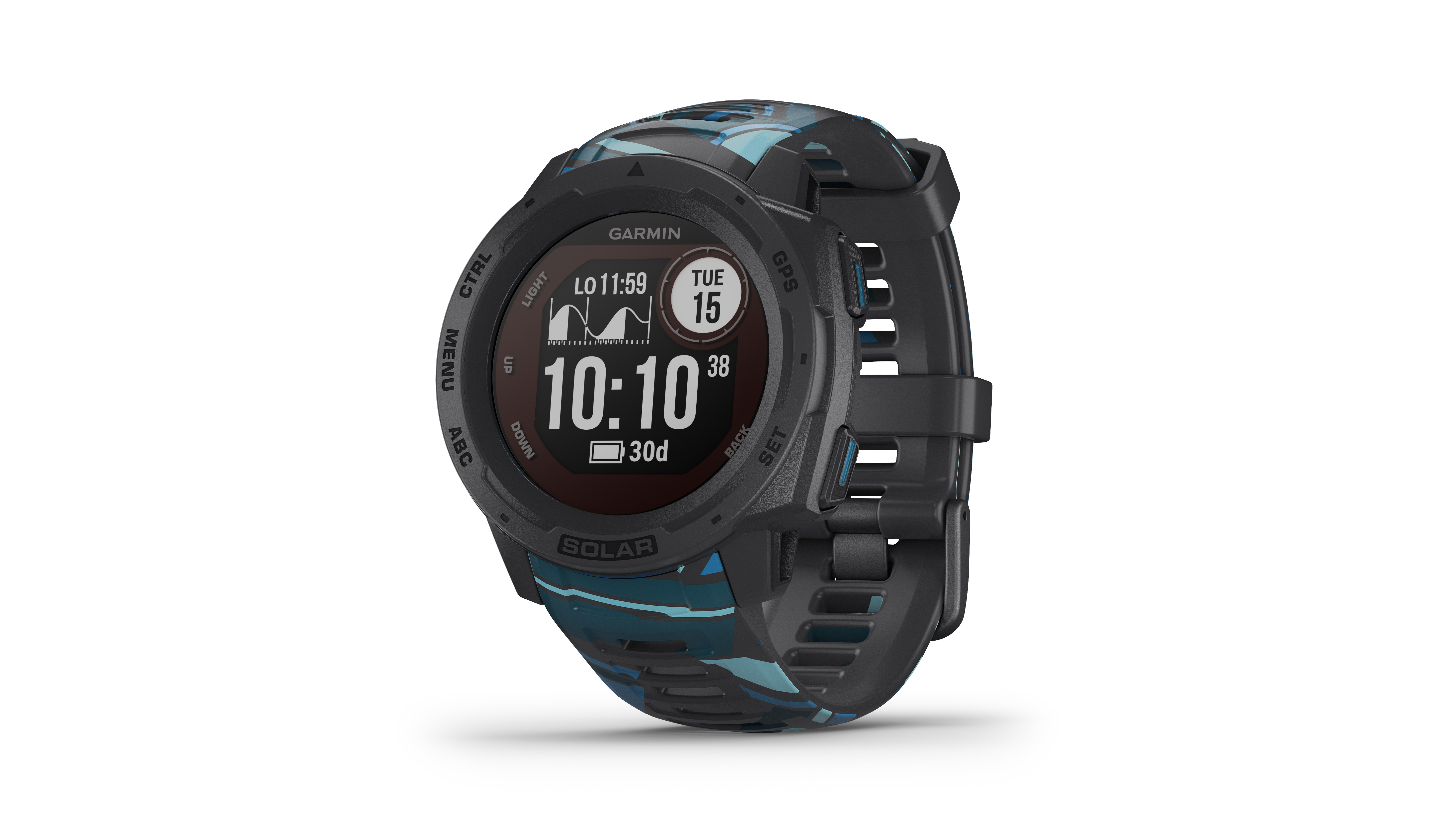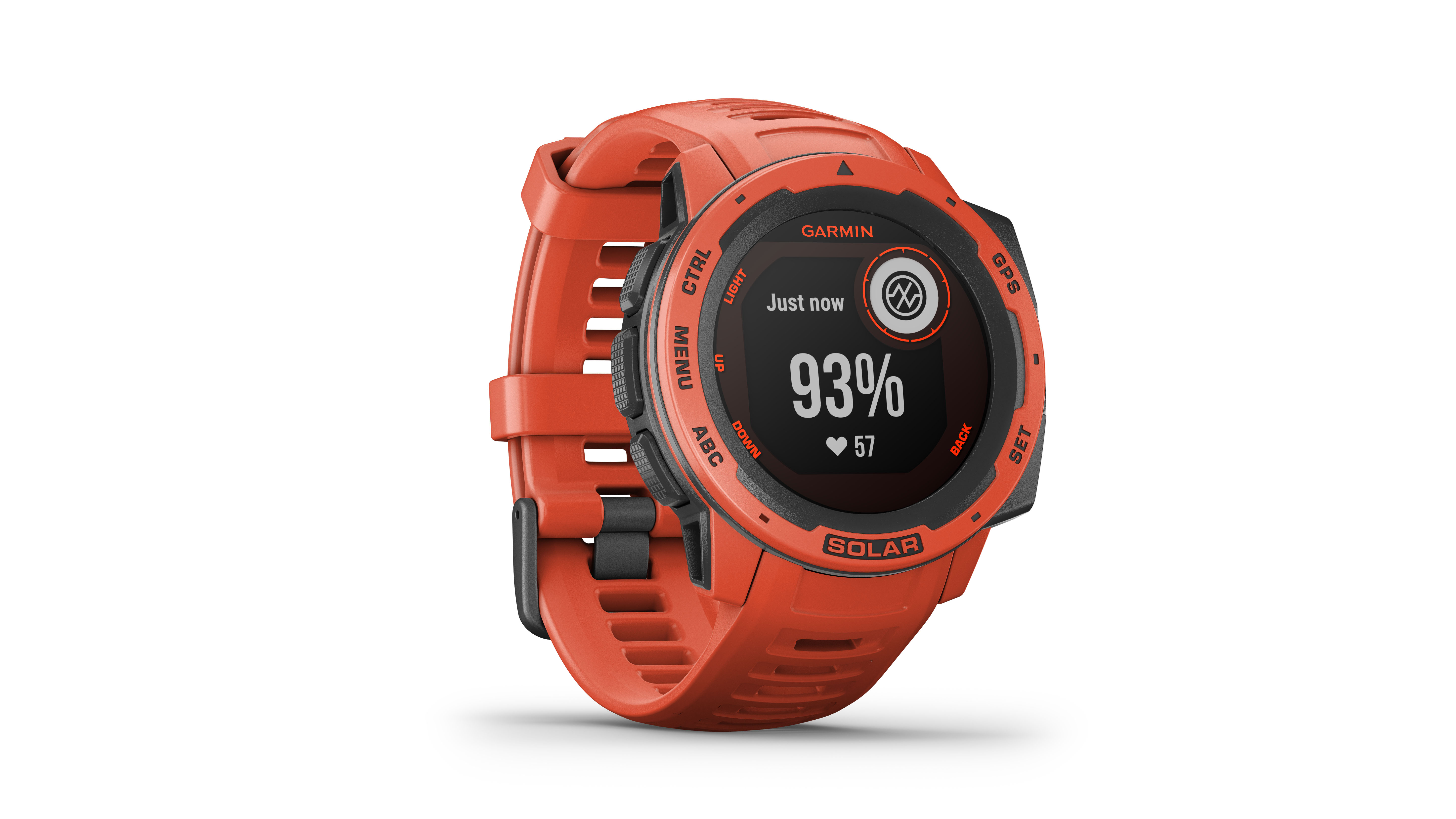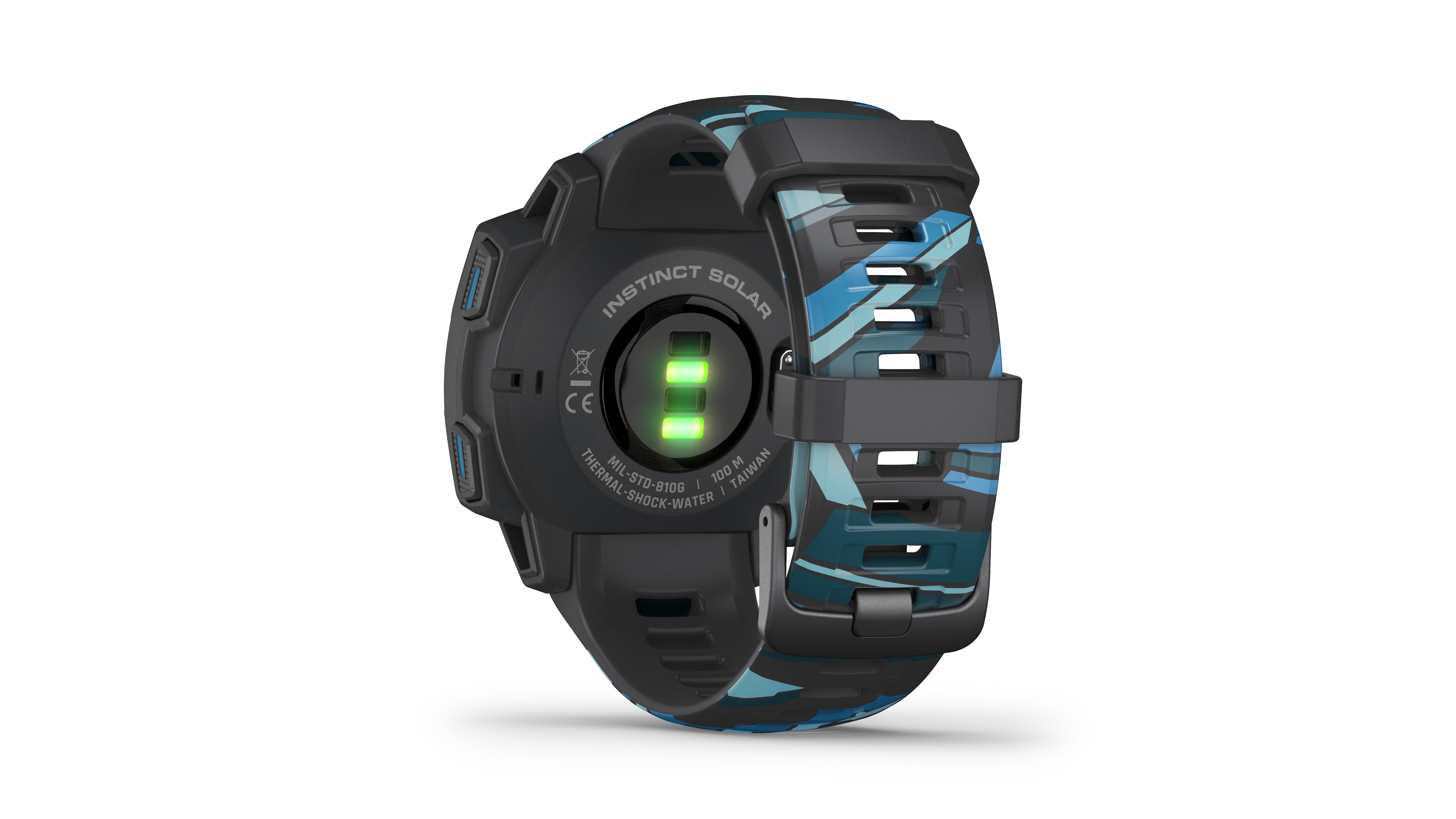Garmin Instinct Solar review: sun-powered Garmin Fenix 6 sibling is tougher than Fitbit for sure
Garmin Instinct Solar review: the extra long battery life is just one of the many perks of this fitness watch


The Garmin Instinct Solar is the smaller sibling of the Garmin Fenix 6 Pro Solar and it comes equipped with a range of casual and hardcore features that many people who like outdoor life and fitness will find useful. The main USP is, of course, the solar charging and the Instinct Solar delivers on this front: if you happen to use the watch for outdoor exercising, as you most likely will, you won’t have to reach for the charger more often than every other week, which is pretty amazing for a watch that has an always-on screen, even if it's 'just' the memory-in-pixel variety.
-
+
Extra long battery life
-
+
Tough exterior
-
+
Plenty of useful outdoor features
-
+
Always-on screen (memory-in-pixel)
-
+
Light
-
-
Monochrome screen
-
-
Straps are not hinged
-
-
All-plastic case doesn’t radiate quality
Why you can trust T3

Garmin Instinct Solar review in one sentence: a premium fitness and outdoor smartwatch with massive battery life, thanks to the Sun. Garmin Instinct Solar is part of Garmin's new Solar range, which includes the updated version of the excellent Garmin Fenix 6 Pro, the equally as good and aptly-named Garmin Fenix 6 Pro Solar, and many other newly released solar versions of recent Garmin watches, such as the Garmin Tactix Delta Solar.
The Garmin Instinct Solar is the most accessibly-priced model of the range, yet it offers plenty of functionality and some key updates compared to the standard Instinct that was released in 2018. Not surprisingly, all this goodness comes at a price: the solar version is £80/$100 more expensive than the old Instinct.
Is the Garmin Instinct Solar worth the price? In my opinion it does as it offers more than just cosmetic updates, especially for people who don't like reaching for the wall chargers more often than every other week. Which is 99% of the population.
Have some more money to burn? Invest in a Garmin Enduro instead.

Garmin Instinct Solar review: price and availability
The Garmin Instinct Solar is available at Garmin and selected third party retailers such as Amazon, Argos, Wiggle, Very and more in the UK and REI and Rock Bottom Golf in the US.
The standard Garmin Instinct Solar retails for £349.99/$399.
- Also consider: Garmin Fenix 6 Pro vs Apple Watch Series 5
Garmin Instinct Solar – Key Specs

Weight: 52 grams
Battery capacity: 178 mAh
Charge time: 2 hours
Features: water-resistant, swimproof, dust-resistant, scratch-resistant

The Surf Edition has a dedicated surf sport profile
Garmin Instinct Solar review: different editions
The Garmin Instinct Solar comes in four different editions:
Get all the latest news, reviews, deals and buying guides on gorgeous tech, home and active products from the T3 experts
- Standard Edition: the base model that has all the key features including pulse oximeter, ABC sensors, military standard rugged casing etc.
- Camo Edition: Feature-wise it's the same as the standard edition, the only difference is the colouring of the case and the strap. I guess it might make your wrist less visible in the forest?
- Surf Edition: this version includes specialised surf features such as tide data and a dedicated surfing activity profile.
- Tactical Edition: the smaller sibling of the Tactix Delta Solar, this variety comes equipped with tactical-specific features such as night-vision goggle compatibility and Stealth mode, the latter which cuts off GPS tracking so you can sneak into places without getting noticed.

Both versions look quite similar, the main difference is under the bonnet
Garmin Instinct Solar review: Garmin Instinct vs Garmin Instinct Solar
The main difference between the regular and the solar edition of the Garmin Instinct is the inclusion of the Power Glass in the latter, a light-sensitive layer sandwiched between the protective lens and the display. Despite the photovoltaic sensor covering a large area, the useful screen space hasn't got smaller in the solar edition.
The Garmin Instinct Solar also houses a blood oxygen sensor and the newer Elevate heart rate sensor, as well as a different GPs chipset (Sony) and longer battery life in GPS mode (probably thanks to the more energy-efficient GPS chip). The new Solar Edition has similar power management option as the Garmin Fenix 6 Pro.
- Garmin Forerunner killer? Wahoo Elemnt Rival running and tri watch looks stunning and has some cool new features

Rough and tough
Garmin Instinct Solar review: build quality and ergonomics
The Garmin Instinct Solar inherited the ruggedness of the standard edition and it is water-rated to 100 metres as well as being constructed to US military standard 810 for thermal, shock and water resistance. The corning Gorilla Glass lens protects the hardware adequately although truth to be told, I never really test the scratch-proofness of these watches. It looks though for sure.
The raised bezel adds an extra layer of protection and possibly keeps the occasional branches and rocks away from the lens. The case is reinforced plastic and although the all-plastic construction doesn't radiate quality, it does the job just fine.
The silicone strap is not hinged which might have a negative effect of how well the Garmin Instinct Solar fits on smaller wrists. for the same reason, the strap is not interchangeable either.
The buttons follow the standard Garmin layout: you have three on the left hand side of the case and another two on the right hand side. If you ever used a Garmin watch before, you'll know what to do, but just to reiterate:
- Top left button: short press toggles the background light, long press brings up the quick access menu
- Middle left button: short press it to navigate 'up', long press it to access system menu
- Bottom left button: short press it to navigate 'down', long press it to quick-access ABC sensor widgets
- Top right button: short press to access sport modes, long press it to acquire GPS signal
- Bottom right button: short press it to go 'back', long press it to access alarms and timers

Lasts longer than your phone
Garmin Instinct Solar review: battery life
Where the Garmin Instinct Solar really shines is the battery life. Not only the photovoltaic layer effectively collects sunlight and tops up the battery every time you are outside, but thanks to the battery management options, you can further maximise battery life.
For example, in Expedition Mode, the watch can last for up to 68 days but thanks to the new Sony GPS chip, the battery life in GPS mode has increased from 16 to 38 hours, compared to the standard Instinct. There is also a 'Jacket Mode', as in 'wearing the watch over the jacket', which disables the heart rate sensor so the watch can last longer.
In practice, after charging up when received and wearing the Garmin Instinct Solar for almost all day – not for sleeping, though – for two weeks plus using it for GPS tracking roughly half an hour each day, I'm down to 1/3 battery life, so we can assume that considering average usage, it will last around three weeks with one charge.
It is worth mentioning that I disabled Pulse Ox feature which can affect battery life significantly. I'd recommend having it off and only turning it on occasionally.
In theory, the Instinct Solar can provide unlimited battery life with sufficient solar exposure in Battery Saver mode. Granted, in this mode, not many features will be available and most of the sensors are switched off so probably not many people will have this battery mode on continuously.

Big screen, little screen
Garmin Instinct Solar review: screen
The screen is pretty much identical to the standard edition: you'll get a memory-in-pixel, 128 x 128 px, monochrome, screen-in-screen display, overlaid with the photovoltaic layer that thankfully doesn't obstruct the view at all. The display has a good contract and the strength of the backlight can be adjusted in the quick access menu, in case you are in a bright environment.
The little screen is a quirky solution but it works well to isolate key stats from the rest of the data displayed on the screen. What's displayed on both screens can be customised in the menu and this applies to both the watchface and the sport modes.

Featureful
Garmin Instinct Solar review: features
Ene the standard edition of the Garmin Instinct Solar has a myriad of features for both athletes and casual users alike. Lovers of the Great Outdoors will appreciate the ABC sensors (altimeter, barometer and compass) and the sun- and moon-cycle tracker.
Casual users might like the Pulse Ox and Body Battery Energy Monitor, as well as the music control and smart notifications. The Garmin Instinct Solar tracks all the key metrics of your day including your sport activities, minutes spent exercising, floors climbed, steps taken and calories burned and more.
There is of course a widget showing you how much sun exposure the watch had in the last six hours and you can also check this in Garmin Connect App. I personally don't care all that much about solar intensity as long as it keeps the battery topped up but feel free to peruse the chart on your watch or in the app if you feel like it.

The new Elevate HR sensor does the job just fine
Garmin Instinct Solar review: sensors
One key difference between the original Instinct and the Instinct Solar is that the latter uses the updated Elevate heart rate sensor which provides more accurate readings compared to the previous iteration. Essentially, this is the same HR sensor that's used in the Garmin Fenix 6 Series and the Garmin Forerunner 945, among other newly released Garmin wearables.
We touched on the new Sony GPS chip and apart from it being more energy efficient, it also provides relatively accurate positioning data. not saying it's super accurate as sometimes it did say I went through buildings but on the grand scheme of things and especially considering you don't want minute accuracy on your daily runs, it should suffice.
Other sensors include the aforementioned ABC sensors and the pulse oximeter which should be more than enough for the large majority of people.

Garmin Instinct Solar review: verdict
At the end of the day, the Garmin Instinct Solar doe what it says on the box: it has a long battery life, cool features and a rugged exterior that make this watch the perfect choice for anyone exercising outdoor.
The Power Glass’s photovoltaic surface covers a large area making the Instinct Solar very capable in collecting precious sunlight. Despite the smaller ‘useful’ display area, the information is generally easy to read thanks to the screen-in-screen method the watch uses.
The fibre-reinforced polymer case and chemically strengthened, scratch-resistant Corning Gorilla glass lens makes the Garmin Instinct Solar tough, and not just any tough but military-standard-tough so it can easily withstand some bashing around. The buttons have a nice click response to them and use the standard Garmin layout many runners are familiar with.
The watch itself is a bit bulky and the strap is not hinged which might make it more tricky for people with smaller wrists to find the right fit without tightening the straps too much. Another negative might be the steeper price, compared to the standard version, the base Solar model coming in at £349.99, while the Tactical, Camo and Surf editions being £399.99.
If you are happy to shell out the money for the device, you will get a fitness watch that does so much more than just tracking runs: you’ll get stress tracking, pulse oximeter, multi-GNSS support, ABC sensors, trackback routing, body battery energy monitor and more. And considering all the goodness included, the asking price doesn’t sound all that much.

Matt Kollat is a journalist and content creator who works for T3.com and its magazine counterpart as an Active Editor. His areas of expertise include wearables, drones, fitness equipment, nutrition and outdoor gear. He joined T3 in 2019. His byline appears in several publications, including Techradar and Fit&Well, and more. Matt also collaborated with other content creators (e.g. Garage Gym Reviews) and judged many awards, such as the European Specialist Sports Nutrition Alliance's ESSNawards. When he isn't working out, running or cycling, you'll find him roaming the countryside and trying out new podcasting and content creation equipment.